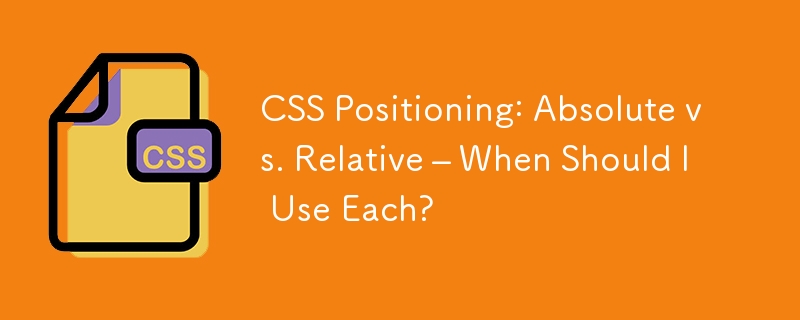CSS Positioning: Absolute vs. Relative – When Should I Use Each?

Positioning Elements with CSS: Absolute vs. Relative
When it comes to fine-tuning the layout of web pages, CSS positioning properties play a crucial role. Understanding the difference between absolute and relative positioning is essential for creating precise and visually appealing designs.
Absolute Positioning
position: absolute; removes an element from the normal document flow and places it at an exact location within the window or its parent container. The four properties used for positioning are top, right, bottom, and left. They act as offset properties, shifting the element from specific edges or points.
For instance, top: 10px; offsets the element 10pixels from the top of the window. Absolute positioning is often used for dropdowns, modals, and fixed elements that need to remain in a specific location.
Relative Positioning
position: relative; keeps an element within the normal flow of the document but offsets its position relative to its current location. This is useful for fine-tuning the placement of elements within a container without breaking the flow.
For example, a paragraph with position: relative; and left: 3em; would move 3em to the left of its current position, while still following the text after it. Relative positioning allows elements to overlap and adjust their positions dynamically based on other elements.
When to Use Each Positioning Type
- Absolute Positioning: Perfect for elements that need to appear in a fixed location, independent of the surrounding content. Used for dropdowns, modals, and elements that must stay within a specific area.
- Relative Positioning: Ideal for adjusting the position of elements within their container, while maintaining their position in the flow. Good for positioning buttons, images, and elements that need minor adjustments.
Additional Notes:
- Absolutely positioned elements have a default width equal to their content, while relatively positioned elements default to 100% width.
- Absolute positioning allows elements to overlap, while relative positioning does not (without using CSS tricks).
The above is the detailed content of CSS Positioning: Absolute vs. Relative – When Should I Use Each?. For more information, please follow other related articles on the PHP Chinese website!

Hot AI Tools

Undresser.AI Undress
AI-powered app for creating realistic nude photos

AI Clothes Remover
Online AI tool for removing clothes from photos.

Undress AI Tool
Undress images for free

Clothoff.io
AI clothes remover

Video Face Swap
Swap faces in any video effortlessly with our completely free AI face swap tool!

Hot Article

Hot Tools

Notepad++7.3.1
Easy-to-use and free code editor

SublimeText3 Chinese version
Chinese version, very easy to use

Zend Studio 13.0.1
Powerful PHP integrated development environment

Dreamweaver CS6
Visual web development tools

SublimeText3 Mac version
God-level code editing software (SublimeText3)

Hot Topics
 1670
1670
 14
14
 1428
1428
 52
52
 1329
1329
 25
25
 1274
1274
 29
29
 1256
1256
 24
24
 A Comparison of Static Form Providers
Apr 16, 2025 am 11:20 AM
A Comparison of Static Form Providers
Apr 16, 2025 am 11:20 AM
Let’s attempt to coin a term here: "Static Form Provider." You bring your HTML
 A Proof of Concept for Making Sass Faster
Apr 16, 2025 am 10:38 AM
A Proof of Concept for Making Sass Faster
Apr 16, 2025 am 10:38 AM
At the start of a new project, Sass compilation happens in the blink of an eye. This feels great, especially when it’s paired with Browsersync, which reloads
 Weekly Platform News: HTML Loading Attribute, the Main ARIA Specifications, and Moving from iFrame to Shadow DOM
Apr 17, 2025 am 10:55 AM
Weekly Platform News: HTML Loading Attribute, the Main ARIA Specifications, and Moving from iFrame to Shadow DOM
Apr 17, 2025 am 10:55 AM
In this week's roundup of platform news, Chrome introduces a new attribute for loading, accessibility specifications for web developers, and the BBC moves
 Some Hands-On with the HTML Dialog Element
Apr 16, 2025 am 11:33 AM
Some Hands-On with the HTML Dialog Element
Apr 16, 2025 am 11:33 AM
This is me looking at the HTML element for the first time. I've been aware of it for a while, but haven't taken it for a spin yet. It has some pretty cool and
 Paperform
Apr 16, 2025 am 11:24 AM
Paperform
Apr 16, 2025 am 11:24 AM
Buy or build is a classic debate in technology. Building things yourself might feel less expensive because there is no line item on your credit card bill, but
 Where should 'Subscribe to Podcast' link to?
Apr 16, 2025 pm 12:04 PM
Where should 'Subscribe to Podcast' link to?
Apr 16, 2025 pm 12:04 PM
For a while, iTunes was the big dog in podcasting, so if you linked "Subscribe to Podcast" to like:
 Weekly Platform News: Text Spacing Bookmarklet, Top-Level Await, New AMP Loading Indicator
Apr 17, 2025 am 11:26 AM
Weekly Platform News: Text Spacing Bookmarklet, Top-Level Await, New AMP Loading Indicator
Apr 17, 2025 am 11:26 AM
In this week's roundup, a handy bookmarklet for inspecting typography, using await to tinker with how JavaScript modules import one another, plus Facebook's
 Options for Hosting Your Own Non-JavaScript-Based Analytics
Apr 15, 2025 am 11:09 AM
Options for Hosting Your Own Non-JavaScript-Based Analytics
Apr 15, 2025 am 11:09 AM
There are loads of analytics platforms to help you track visitor and usage data on your sites. Perhaps most notably Google Analytics, which is widely used




